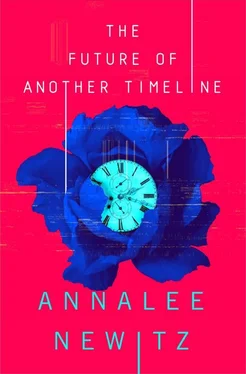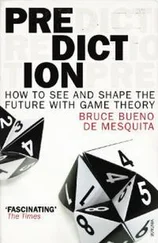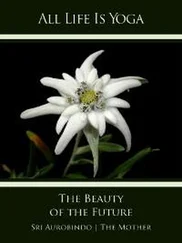Thanks to an unusual loophole in Nabataean law, religious orders could receive gold from the city-state for sacrifices. As long as a refugee claimed to be a “sacrifice,” the Temple of al-Lat had coin to spend on their food and clothing. It helped that the city’s rich women put huge annual donations into Raqmu’s coffers to support this practice. Also, since the “sacrifice” was technically dead, she couldn’t be arrested for traveling without a mark. It was the roundabout and slightly underhanded way that the city made itself a sanctuary.
That evening, Anita led Soph, C.L., Morehshin, and me to an older part of town reached by a long set of stairs curving up the canyon walls. We ascended to the second level of the city here, with houses and shops cut deep into the sandstone along a wide promenade. The Temple of al-Lat was set back from the walkway, behind a garden of fruit and nut trees fed from an elaborate network of cisterns, pools, and pipes.
“This is beautiful.” Soph’s face was radiant. She’d been reading the scrolls with Morehshin and memorizing the ceremony to join the ranks of al-Lat’s protected Timeless. I looked at her sidelong, taking in the kohl-smeared eyes, braided hair, and pale linen robe Anita had dug up somewhere in the AGU quarters. When I first met Soph, I thought she was a sex radical using the language of Spiritualism to spread the cause. Now I knew she was a believer, too. Maybe not a conventional one, but close enough that the Temple of al-Lat meant something more than political asylum to her.
Soph smiled at me and I took her hand.
We entered the temple through an atrium with high windows that brought in sunlight across a brightly painted ceiling. Benches lined a central pool, and people crowded onto all of them, talking and gesturing and eating dinner and staring off into space. Anita introduced us to a dark-skinned woman named Esther, who wore a dress laced up over a loose white blouse that looked vaguely fifteenth century. Her fingertips were dyed with shimmering green ink and she tucked a wooden writing kit under her arm before gesturing us down a long, lamplit corridor. The air cooled as we got further into the rock.
After a minute of walking, we made a sharp left and emerged into a palatial room whose walls were covered in wooden shelves of scrolls, mechanical instruments, and jars. A fifty-foot statue of al-Lat rose from the floor to tower over the center of the room, her three faces seeing into every corner. Beyond her skirts, at the far end of the room, a dais was backed by several rows of semicircular stadium seats cut into the high walls. Fresh air came in through portals in the arched ceiling. Dusty beams of sunlight shot through them to a floor mosaic of astronomical charts.
“Welcome, women and new genders.” Esther addressed us in modern English with an accent I didn’t recognize. “The ceremony will take place in the amphitheater.” She gestured at the dais, where a very bored-looking teenager was setting out some candles and our offering of grain.
“Should we go over there and wait?” I’d read a lot about the Temple of al-Lat, but had never actually visited. From my research, though, I had been anticipating something with a little more ritual to it. Everybody’s nonchalance made it seem like Soph was getting a library card rather than temporal amnesty from a cosmic mother goddess.
Esther ignored my question and knocked on a polished wooden door. “Your sacrifice is here, ma’am!”
A woman whose black hair was wound into tightly coiled ringlets emerged from behind the door, wrapping a blue shawl over the deep brown of her shoulders. “I’m Hugayr. These are my students, but you can ignore them. They’ll be observing.” She spoke in crisp Nabataean, though she obviously understood English, too. Following her were three women with writing kits like Esther’s, all wearing identical harried expressions. We trailed Hugayr to the amphitheater, where the teenager lit candles and joined a few other women on the benches. Everything smelled pleasantly of beeswax.
Hugayr pulled three carved stones from her robes and set them on the dais. Each had been cut to resemble a flower and emitted a blue glow, as if infinitesimal LEDs were embedded in its crystal matrices. “There will probably be a crowd of students here,” she said. “I hope you don’t mind. We only get a couple of sacrifices every year, so it’s a great chance for them to get some experience.”
When Hugayr invited Soph to lie down on the dais between the candles and stones, more women in the room wandered over to sit down, or left discreetly through the doors. At last there was enough of a crowd that it was starting to feel properly ceremonial.
“All right, everybody, let’s get started.” Hugayr said it with an unmistakably southern American accent from the twentieth century, then switched back into Nabataean. “Welcome, Soph. Your offerings and sacrifice are pleasing to al-Lat, who gives shelter to women and new genders who have been cast out of the time when their mothers birthed them.”
“Praise be to al-Lat.” Soph spoke in a clear, strong voice.
“This the most difficult part, so pay attention.” Hugayr addressed the audience. A few had taken out scrolls and ink. I could hear the faint scratching of reed pens on papyrus. Palming two of the stone flowers she’d set out, Hugayr held her fists over Soph’s chest and let out a prolonged cry. “DIE AND LIVE AGAIN!”
Blue fire enveloped Hugayr’s arms and fell across Soph’s body like lumps of lava. She sucked in her breath and let out an ecstatic scream. My muscles tensed. This looked too much like a real sacrifice, and not the metaphorical one I’d expected. But no one around me was panicking, so this was obviously part of the ritual. I peered more closely. Where had the fire come from? It burned everything, but consumed nothing. That’s when I realized: the stones. They were raining illumination, like Morehshin’s multi-tool. Somehow these ancient priestesses had access to technology from thousands of years in the future. I tried to relax. This was not going to end in carnage. Soph would be fine.
“CALL THE WATER IN THE ROCKS, SOPH! CALL IT!” Hugayr opened her hands and the stones blazed. Though at first I’d thought they were carved into flowers, perhaps those petals were flames.
Soph stood up, towering over us, cloaked in fire. “I CALL THE WATER!” The air instantly poured with rain and fog. I could smell the Ordovician again, and through the mist I saw embers dying.
“Is she going to be okay?” I couldn’t help but whisper it.
C.L., grinning next to me, practically bounced with glee. “Yes! This place has its own mini-wormhole. You’ll see.”
Now Soph was floating upward, her hair free around her face. Smoke and steam plumed from the rocks below, where Hugayr gesticulated for her students to clean up spilled wax and water. Soph spun slowly toward the statue of al-Lat as she reached the height of the goddess’s faces. She was fully thirty feet above the dais now. Electricity buzzed around her.
“GODDESS, DO YOU ACCEPT MY SACRIFICE?”
A ball of lightning cracked where Soph hung suspended. She winked out, then reappeared on the dais in a burst of seawater.
“LET DEATH AND LIFE JOIN IN THE BODY OF THE TIMELESS!” Hugayr raised her arms and the air was clear again. I could hear water dripping from Soph’s robe onto the floor. The students were working frantically to soak everything up with sponges and cloth. C.L. applauded enthusiastically, and the rest of us joined in, some snapping fingers or stamping their feet.
“Nice job, everybody! Very controlled.” Hugayr beamed and folded her arms. “You are now Timeless, Soph! Welcome!”
Soph grinned and wrung out her hair. I still felt a little shaky, but joined the others swarming her with hugs while students in the audience headed back to work.
Читать дальше








![Аннали Ньюиц - Автономность [litres]](/books/424681/annali-nyuic-avtonomnost-litres-thumb.webp)



